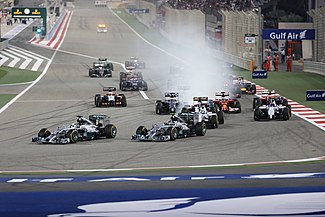Single-seater racing car

Lewis Hamilton takes the lead at the start of the 2014 Bahrain Grand Prix
|
|
| Characteristics | |
|---|---|
| Contact | Yes |
| Team members | Yes |
| Mixed gender | Yes |
| Type | Outdoor |
Formula racing is any of several forms of open-wheeled single-seater motorsport. The origin of the term lies in the nomenclature that was adopted by the FIA for all of its post-World War II single-seater regulations, or formulae. The best known of these formulae are Formula One, Two, Three and Four. Common usage of "formula racing" encompasses other single-seater series, including the GP2 Series, which replaced Formula 3000 (which had itself been the effective replacement for Formula Two).
Categories such as Formula Three and GP2 are described as feeder formulae, which refers to their position below Formula One on the career ladder of single-seater motor racing. There are two primary forms of racing formula: the open formula that allows a choice of chassis or engines and the control or "spec" formula that relies on a single supplier for chassis and engines. Formula Three is an example of an open formula, while Formula BMW is a control formula. There are also some exceptions on these two forms like Formula Ford where there is an open chassis formula but a restricted single brand engine formula.
In the process of reviving Grand Prix racing after the end of World War II, the Fédération Internationale de l'Automobile's Commission Sportive Internationale was responsible for defining the standardised regulations of Formula One (F1) in 1946. The first race to be run to the early Formula One regulations was a non-championship Grand Prix in Turin in September 1946. The first officially recognised Drivers' World Championship was held in 1947 and the Formula One World Championship was inaugurated in 1950. This was the first example of formula racing.
...
Wikipedia
